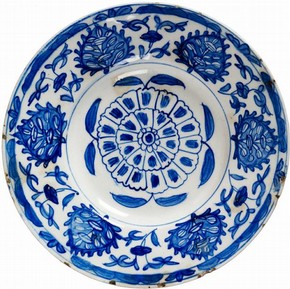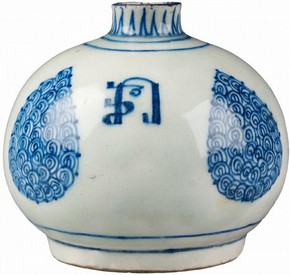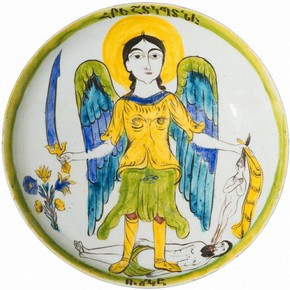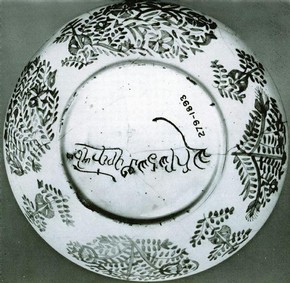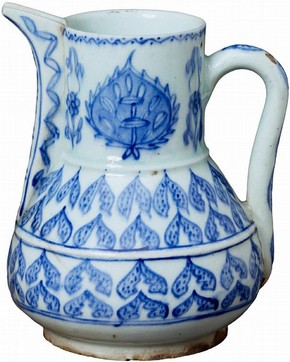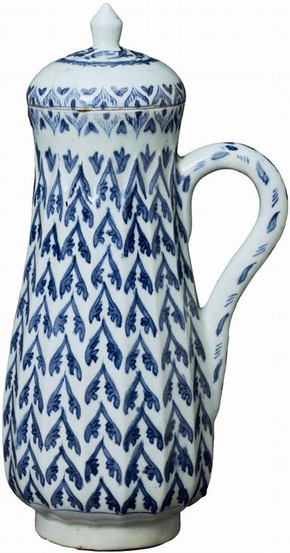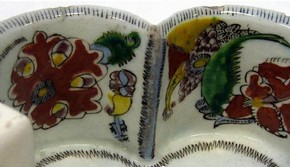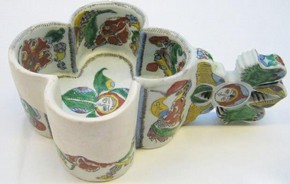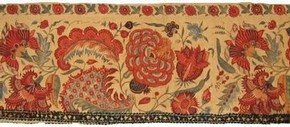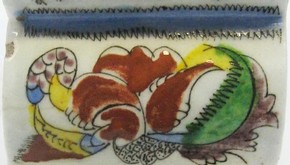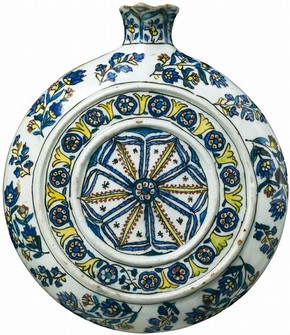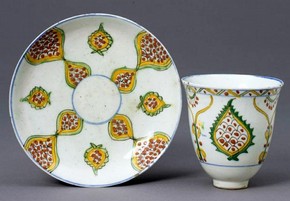V&A Online Journal
Issue No. 3 Spring 2011
ISSN 2043-667X
Kütahya ceramics and international Armenian trade networks
Independent scholar
Abstract
Although 18th-century Kütahya ceramics have gradually begun to find their place in collections both in Turkey and the Gulf, little scholarly attention has been given to their unique designs and shapes. There are over seventy pieces in the Victoria & Albert Museum’s collections, offering the possibility of studying the ceramic production of this relatively small Anatolian town on the Anatolian plateau, some hundred kilometres south-east of Bursa and Iznik.
Although 18th-century Kütahya ceramics have gradually begun to find their place in collections both in Turkey and the Gulf, little scholarly attention has been given to their unique designs and shapes. In 1957 Arthur Lane simply wrote that ‘the [Kütahya] factories specialized in rather slight and trivial wares, with a side-line in tiles’. (1) There are over seventy pieces in the Victoria & Albert Museum, offering the possibility of studying the ceramic production of this relatively small Anatolian town on the Anatolian plateau, some hundred kilometres south-east of Bursa and Iznik. Iznik has for a long time been the only reference to Ottoman ceramics recognised in the West, with its impressive production of colourful tiles and dishes made in the 16th and 17th centuries to enhance mosques and palaces of the Sultan and his court. Yet Evliya Celebi in 1670 recalls among the thirty-four quarters of Kütahya one being ‘the quarter of the infidel china-makers’. (2) Earlier records state the existence of an Armenian community in Kütahya already by the end of the 14th century when the Cilician kingdom of Lesser Armenia collapsed under the Mamluk thrust and Armenian families were scattered once more throughout the Mediterranean and Ottoman territories. In 1444 records mention a potter’s gift to the Holy mother of God’s church in Kütahya. Furthermore the decoration on the two famous pieces dated 1510 and 1529 in the British Museum, comes close to that of the Iznik production of the time. Shards from excavations in Kütahya have brought to light similar patterns which would prove that potteries in that town added to the production of those overworked in Iznik.
By combining the V&A’s collection, which comprises an interesting variety of shapes and colourful decorations, with an earlier study of blue and white examples of jugs and dishes from other museums, a considerable archive of objects is created on which we can comment. (3) The most ubiquitous design on these ceramics is of a cone shape; this is used repeatedly on dishes and bowls. This cone pattern migrated from Chinese export porcelain to late Safavid Persian wares as can be seen in the dish on figure 1(a particularly early example). This migration came about because Persian potters were exposed to it from the late 17th-century Kangxi (r.1662-1722) models. Christian potters who were threatened by the religious intolerance of the Safavid rulers, may have moved to Kütahya bringing with them their new decorative vocabulary. At this time Kütahya welcomed religious minorities, thanks to the relatively tolerant policies of Suleyman III and his vizier Fadil Mustafa Pasha Köprülü (1637-1691). This infusion of new blood and ideas must also have given Kütahya potters a greater awareness of the world beyond the limits of the Ottoman Empire.
If this is the case then the 'sudden' apparition of new patterns such as the cone, on blue and white Kütahya ceramics would make sense. The transition from Persia to Turkey can also be illustrated by a group of three late Safavid pieces in the collection, each of them with the Armenian monogram of Paron Sarfraz; he was the wealthy head of a New Julfa merchant family from 1701 until 1727, which provides helpful dating. (4) One of the pieces, a Persian broken water sprinkler, is decorated with three cones and the Sarfraz monogram (fig. 2). The appearance of the cone pattern on Kütahya pieces may then date to the early years of the 18th century.
Further dating of another type of blue and white decoration has been gathered from four polychrome narrative dishes, one of which belongs to the Museum (fig. 3). The other three are kept in the Armenian monastery of San Lazzaro in Venice, the Musée d’Art et d’Histoire in Brussels and the Cincinnati Art Museum. Although the narrative is painted in polychrome it is worth examining the back of the dish not only for a possible signature but also for its decoration. In this particular case, with the Islamic date equivalent of 1718 painted on the front rim, we have a date for the use of the blue and white flower spray pattern on its back. Consequently the blue and white dish (fig. 4) can be dated to around that period of time. The flower spray offers another example of the influence of Kangxi export wares.
The polychrome dish in the Safavid group, which depicts the figure of the Archangel Michael receiving the soul of the dead man, is one of a series given to the Armenian cathedral of Saint James in Jerusalem by Vartabed Abraham in 1168-1718 according to the inscription (fig. 3). The naïve style of painting appears to relate to the religious narratives on tiles covering some of the walls of the said cathedral. It has been suggested that the long tradition of gospel paintings in Armenian monasteries would have been a source for such narratives. Yet such themes taken from the Bible or Armenian Church history illustrate the scrolls of more popular prayer rolls, some of which date back to the 17th century. (5) The quality of their design is closer to folk art than to the long tradition of stylized monastic painting. (6)
A further unusual pattern appears on pourers such as a jug and a coffee pot in the collection (figs. 5 & 6). Once more the original design used as a border originates on a Kangxi jar such as on an example from the Topkapi Saray Museum collection no.2094. Whether pairs of leaves, wings, wishbones or pincers, it is hard to understand such a repeat pattern, which may explain its short life in the Kütahya pattern book. One similarly decorated coffee pot belongs to the Kerr Collection (C.107 1988). Its shape lacks a lid but the free-hand painting repeats the pattern more regularly.
Despite earlier attempts to explain the links between blue and white Kütahya pieces and Chinese Kangxi export wares, the polychrome production in the first half of the 18th century with its striking motifs, continue to baffle specialists. Yet in the light of the Armenian trade network across Eurasia, it is possible to discover other influences besides those of far-eastern ceramics. Indian painted cottons, known as chintzes, had conquered the Eurasian world of fashion and by now were part of a worldwide trade. Could it be that the designs on these fabrics also attracted the Kütahya potters? (7) This suggestion was made in the 1980s by Jean Soustiel who proposed a link between the textile production of the Indian Coromandel Coast and Kütahya ceramics, but he did not pursue this original approach any further. (8)
Understanding the Armenian trade network
Early in the 17th century Shah Abbas of Persia with great foresight, transported the population of Armenian Julfa, a prosperous trading town on the northern bank of the river Arax, to the heart of Persia. The core of the Armenians who survived the winter crossing of the river, were resettled either in Gilan, south of the Caspian, or in the region of Isfahan. About twenty merchant families of great wealth were moved briefly to Isfahan before being allowed to create a New Julfa - Nor Djougha - across the river from the Safavid capital. Besides normal trade, these families were to be responsible for the silk trade of the realm which brought prosperity to the country until the decline of the Safavid dynasty in the last decades of the 17th century and its fall to the Afghans in 1722. (9)
Although the Julfa Armenian community was profoundly disrupted by such events, their existing international network which stretched from Lisbon to Canton was not unduly threatened; some families had even lived in Lhasa for over thirty years as the extortionist policies of Nadir Shah (r.1736-48) eventually undermined the prosperity of the Armenian merchants of Persia. Earlier generations of Armenians, as mentioned above, had already settled in several Anatolian towns not withstanding a large number in Istanbul. In Venice the first Armenian printed book was produced in 1512, and in 1666 the first Armenian Bible was printed in Amsterdam where Armenian merchants had traded in their own market since the 1550s, the eastern market. (10) They were known as Christian Persians and by 1713 had built their own church of the Holy Spirit.
In India by 1563 an Armenian church was standing in Agra and factories were active over most of the subcontinent. Although in the 17th century the Gujarati port of Surat was indeed an international hub for all trade including painted cottons, by 1661 a number of foreign factories moved to the new English possession, the island of Bombay, being the Portuguese dowry of Charles II’s wife, Queen Catherina. On the eastern side of India what was eventually to become the town of Calcutta also offered increasing trading facilities. And as more problems beset Surat, the Coromandel Coast gradually gained in importance. One particular aspect of its production was the fineness of its painted cottons providing goods for a large foreign market including the whole of Asia and Europe. The conditions for manufacturing these cottons were excellent. Once the monsoon was over and the flow of the rivers had calmed down, the quality of their waters was exceptionally suitable for the rinsing and dying of cloths destined for the various export markets of Japan, Indonesia, Malaya, Persia, Turkey, the Mediterranean and North Sea worlds.
In his Histoire philosophique des Etablissements et du commerce des Européens dans les deux Indes, l’abbé Raynal wrote in 1770:
'Ces ‘négotians [Arméniens] avaient entrepris depuis longtemps le traffic des toiles. Ils n’avaient été supplantés, ni par les Portugais, qui n’étaient occupés que de pillage, ni par les Hollandais, dont les épiceries avaient fixé toute l’attention. On pouvait craindre, d’ailleurs, de ne pouvoir soutenir la concurrence d’un peuple également riche, industrieux, actif, économe. Les Arméniens faisaient alors – ce qu’ils ont toujours fait depuis. Ils passaient aux Indes; ils y achetaient du coton; ils le distribuaient aux fileuses; ils faisaient fabriquer des toiles sous leurs yeux; ils les portaient à Bender-Abassi, d’où elles passaient à Isfahan. De-là, elles se distribuaient dans les différentes provinces de l’Empire, dans les états du grand-seigneur et jusqu’en Europe, où l’on contracta l’habitude de les appeler Perses; quoiqu’il ne s’en soit jamais fabriqué qu’à la côte de Coromandel. (11)
This text once more underlines the vast network of international trade manned by a remarkable group of merchants consisting of faithful members of the great Armenian trading families and their agents contracted to them by the commenda system. (12) Whether by sea or by land, for personal or church use, Indian painted cottons and chintzes reached the realm of the grand-seigneur, in other words the Ottoman empire, Kütahya and far beyond.
An exceptional incense holder
The lobed incense burner is one of a few examples of objects expressly made for the Armenian community over a short period of time, probably in the first half of the 18th century; which would explain the small number still in existence. The V&A has two pieces, one in blue and white with six lobes and a square-section handle as high as the body itself; the other in polychrome made up of four lobes and with an unusual vertical solid grip for a thumb and index hold (fig. 7a). The deep shape of these lobed containers reflects the need for a protection against the burning incense; both inner and outer walls are decorated and six-winged seraphim fill both centers. The specific design of an angel, also painted on many egg-shaped hangings, decorates in yellow and green the five lobed outer walls of another incense burner from the Monastery of San Lazzaro dated 1740. (13) This piece lacks its square-section handle. Blue and white floral designs fill the inside of the piece, not unlike that of the V&A’s blue and white incense holder (inv. 595.1892).
Apart from the seraphim in the centre and on the handle, the bizarre painting on the V&A’s polychrome incense burner differs from earlier examples of ornament noticed on dishes. At first sight, these bold red patches with green and yellow additions (fig. 7b) hardly make sense; there appears to be no other ceramic production of the time which could have influenced such designs. Yet by searching beyond the field of ceramics, it is possible to find a link between painted Indian cottons and the unusual design on the incense burner. Early in the 18th century the fashion of chintz had conquered the whole of Europe, and these Indian painted cottons were also part of the Armenian world trade. In fact some Armenian communities ordered church altar curtains with borders displaying patterns of leaf and flowers similar to those on large palampores. (14) That the potters of a small township like that of Kütahya should have responded to such a visual challenge demonstrates how the keen eye of a craftsman can pick out new ideas from unusual textile patterns and adapt them to the shapes of the day in his own ceramic world.
For example, in this typical fragment of chintz from the V&A’s collection (fig. 8a) we can easily appreciate the connection between textiles and ceramics. The details of such strange leaves and flowers could not be reproduced faithfully on the small ceramic surface of the incense burner, thus the potter only recreated the strong visual impact of the contour and the deep red colour. The serrated leaves are green and the use of a striking bright yellow adds to the warm colouring of the display. But was such a strong tint also part of the painting on chintzes? No longer visible today, the colour has faded away on surviving cottons; but unexpectedly the memory of its brightness has been fired into the unblemished decoration of this incense burner. Beyond colour, a closer inspection of the handle pierced in two places (fig. 8b), has brought to light what could be a four-lettered Armenian date painted black on yellow in reverse. It reads as 1174 corresponding to 1725 and placing the incense burner in the creative period of Kütahya. Only one other piece in the V&A collection comes close to this striking polychrome decoration: a bowl 16cm. wide (inv. C403-1910) which makes use of the deep red to enhance four overblown cones with yellow veins amidst red spotted leafy elements.
Polychrome pilgrim flasks and coffee cups
The special shape of the pilgrim flask or gourd has a long history in Eurasian culture; in western Asia there are slight variations in size and thickness reminiscent either of Indian metal shapes or Persian ones. A late 15th-century Iznik piece with six lugs belongs to the Musée National de la Céramique de Sèvres: the whole body is covered with a dense decoration of blue and white leaf scrolls in reserve (inv. 15472). By contrast in the 18th-century potters of Kütahya seem to have fancied the shape, and over the years the Museum acquired a number of them with shapes slightly different in thickness and number of lugs, mostly decorated in polychrome. Two pieces (inv. 598-1894 and inv. 903-1907) recall the Iznik shape, but the decoration is closer to well known Ottoman textile embroideries; a banal flower painting fills the broad shape about 7cm wide, with a double recess on both sides. The profile of another type of gourd (inv. C2035-1910) is narrower with six lugs for hanging; on either side a female figure stands between two stylised trees. The example reproduced here is closer in shape to the two first examples with its double recessed centre on either side (fig. 9). Yet the design is far more elegant with attractive flower sprays in blue, white and yellow on the shoulder. The red colouring in the flowers and rosettes of the circle is hardly visible. The six-petal centre is also reminiscent of the Iznik period, but very different from the petal-panels of earlier lotus flowers typical of Iznik wares.
Better known pieces of Kütahya production are the coffee cups and saucers which owed their popularity to the discovery and import of coffee beans into Asia in the 18th century. Despite the prohibition of coffee drinking (Mecca in 1511 and Cairo in 1532) by the middle of the century the new beverage had become a favorite drink in the Ottoman Empire.
‘Until the year 962 [1555], in the High, God-Guarded city of Constantinople, as well as in Ottoman lands generally, coffee and coffee-houses did not exist. About that year, a fellow called Hakam from Aleppo and a wag called Shams from Damascus came to the city. They each opened a large shop in the district called Tahtakale, and began to purvey coffee’. (15)
Some of their designs are more sophisticated than others. The cone shape appears regularly as well as small flower sprays. The V&A’s cup and saucer illustrated here, is a standard example of the better quality from the Kütahya kilns (fig. 10). The painting is meticulous and the design well proportioned. The cups have been classified into two main groups, those with holders either in metal or ceramic, and those without holders either standard or a little taller, but with saucers. Decoration seems to have differed according to the destination of shipments: as can be noticed in a wreck discovered in the 1980s in the bay of Kartal not far from Istanbul. Yet such was the success of these ceramics that shards of them have appeared across the world from excavations in Williamsburg (USA), Aleppo, the ports of London, Ostend and Amsterdam to the mounds of Fostat near Cairo, the shores of Malaysia and shipwrecks of East Indian companies off the coast of South Africa.
Conclusion
Besides catering for the Armenian community, the potters of Kütahya understood the requirements of a Mediterranean market. By responding to the leading fashions of the day they succeeded for a short while in producing ceramics for a world market. Drawing on Indian painted cottons as an inspiration for polychrome designs, they enhanced the best of their production. (16) Furthermore the social requirements for the newly introduced drinking of tea, coffee and chocolate led the potters to copy some European shapes besides money boxes modeled into small coffer shapes. With Ottoman lands being a halfway house between Europe and Asia and the remarkable area covered by Armenian merchants, it is not surprising that for a short time the fame of Kütahya spread across Eurasia.
Unfortunately, by the middle of the 18th-century European competition from Meissen and other European porcelain centers made Kütahya productions look less attractive. It was becoming more and more difficult to attract the international market with the production of porcelain having started in Saxony around 1710. Furthermore, the cheaper technique of transfer printing, discovered in Liverpool by John Sadler in 1755, had made ceramics cheaper to acquire for a wider public. By this time Kütahya potteries were offering indifferent patterns and coarser brushwork which could no longer rival the more sophisticated wares produced on an industrial scale. By the 19th century and to this day the decorative vocabulary of Kütahya has reverted to the patterns made famous in 16th-century Iznik. Yet further studies should be undertaken on the production of Kütahya in the early 18th century. It is to be hoped that more detailed work on shapes of ewers, gourds, coffee pots, bowls, cups and saucers will yield further information on those fast changing tastes in Europe. The classification of numerous folk figures animating dishes, gourds and ewers, would also bring forth a great fashion parade!
Endnotes
(1) Lane, Arthur. Later Islamic pottery. London: 1957: 63.
(2) John Carswell J. and Charles J.F. Dowsett. Kütahya tiles and pottery from the Armenian Cathedral of St. James, Jerusalem. (2 vols.) Oxford, 1972, vol. II: 8.
(3) Crowe, Yolande. 'Kütahya patterns: Out of the blue?' in Transactions of the Oriental Ceramic Society. 71 (2006-7): 45-52.
(4) New Julfa was the Armenian part of the town of Isfahan, south of the Zarafshan river.
(5) Armenia Sacra. Prayer rolls, Musée du Louvre, 2007: 440-1.
(6) Crowe, Yolande. 'Kütahya patterns: Out of the blue?' in Transactions of the Oriental Ceramic Society. 71 (2006-7): 51.
(7) Crowe, Yolande. 'Slip painted wares and Central Asia' in Transactions of the Oriental Ceramic Society. (1987): 58-68.
(8) Soustiel, Jean. La céramique islamique, le guide du connaisseur. Fribourg: 1985: 347.
(9) Aslanian, Sebouh. 'Social capital, Trust and the role of networks in Julfan trade: informal and semi-formal institutions at work' in Journal of global history. 1:3 (2006): 383-402.
(10) Baibourtian, Vahan. International trade and the Armenian merchants in the seventeenth century. New Delhi, 2004: 124.
(11) Raynal, Guillaume .T. Histoire philosophique et politique des Etablissemens et du commerce des Européens dans les deux Indes. (vol.II). Genève, 1782: 22. The first publication was printed anonymously in Amsterdam in 1770.
(12) The commenda is a type of commercial contract. S. Aslanian, 'The circulation of men and credit: The role of the commenda and family firm in Julfan society', in Journal of the economic and social history of the Orient. 50:2 (2007): 124-171.
(13) Magic of clay and fire, Garo Kürkman, Istanbul 2006, no. 248. H: 9.1cm, W: 11.6cm.
(14) Crill, Rosemary. Chintz, Indian textiles for the West. London, 2008: nos. 33-4.
(15) Lewis, Bernard. Istanbul and the civilisation of the Ottoman Empire. University of Oklahoma press, 1989: 132. A quotation from the Ottoman chronicler İbrahim Peçevi.
(16) Crowe,Yolande. 'A Kütahya bowl with a lid in the Walters Art Museum' in The Journal of the Walter Arts Museum. 64/65 (2006-7): 199-206.
Issue No. 3 Spring 2011
- Editorial
- Promoting corporate environmental sustainability in the Victorian era: The Bethnal Green Museum permanent waste exhibit (1875-1928)
- ‘Nothing of intrinsic value’: The scientific collections at the Bethnal Green Museum
- Shedding light on the digital dark age
- John Thomas and his ‘wonderful facility of invention’: Revisiting a neglected sculptor
- Dialogues between past and present: Historic garments as source material for contemporary fashion design
- Kütahya ceramics and international Armenian trade networks
- X-radiography as a tool to examine the making and remaking of historic quilts
- A patchwork panel ‘shown at the Great Exhibition’
- An adorned print: Print culture, female leisure and the dissemination of fashion in France and England, around 1660-1779
- Seating and sitting in the V&A: An observational study
- Review: The Actor in Costume by Aoife Monks
- Review: Not quite Vegemite: An architectural resistance to the icon
- How to submit a proposal to the V&A Online Journal
